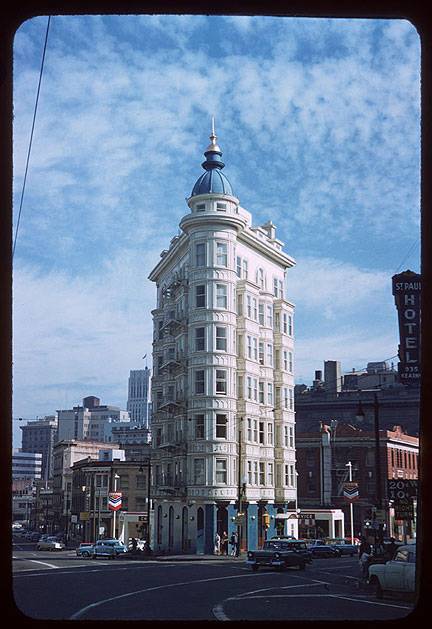NOTE: Columbus Tower, also known as the Sentinel Building, is technically on the very edge of Chinatown on the border of North Beach, Chinatown, and the Financial District. As it's on the east side of Kearny, it is technically not in Chinatown, but it is so close, I am including it as a bonus.
At the northeastern corner of Chinatown, at the corner of Kearny, Columbus, and Pacific, is a building that stands out, being mostly green, and triangular in shape. This is the Sentinel Building, aka Columbus Tower.
 |
| Google Maps 3D View of 916 Kearny, the Sentinel Building |
Finished in 1907, the building was actually under construction when the city suffered the Great Earthquake of 1906. As architecture goes, this was considered a Beaux-Arts flatiron building, mainly built between 1880 and 1926, and they are unique in that they are shaped like old fashion iron for clothes, and used when odd lot shapes require unusual building shapes for maximum square footage. Unique for their time, flatiron buildings use steel frames over reinforced concrete and were quite sturdy.
The Sentinel building itself has 8 floors above ground, plus a very large basement. The modern green exterior was a result of the coppery patina, as the original exterior was white.
 |
| Sentinel Building circa 1960, you can see it is very white Charles Cushman Collection: Indiana University Archives (P10965) |
The building has several famous owners, probably the first was the notorious Abe Reuf. A child prodigy, Reuf spoke 8 languages, including Cantonese, graduated from University at 18, and passed the bar at 21. He decided to go into politics, but only as a consultant for he does not like the limelight. He allegedly once said he can get anyone elected if given a month to train him, and he did get Eugene Schmidt elected, then packed the city board of supervisors with similar people. From there, if anyone needed a law passed in the city or a project approved, they just need to "hire him" as a consultant, and he keeps 50% of the fee, and pass on the rest to his cronies on the board. Unfortunately, he later got caught for bribery and spent 14 years in San Quentin prison. After he got out, the only thing left was the building.
During Prohibition, the building was home to Caesar's Grill, a notorious speakeasy. In fact, there are many who believe that this is where the Caesar Salad was invented. In the 1950s the basement was home of the Hungry I, a famous nightclub that started the careers of many stars we knew and love today.
In 1958 Rob Moor bought the building for investment, as the building was not that well liked and some say it should be demolished. He bought in at the right time, and renamed it Columbus Tower after restoring it. Two years later it was bought by the Kingston Trio (at a substantial markup) who used it as their headquarters, with a recording studio in the basement throughout the 1960s.
The building got its name reverted back to Sentinel Building in 1970 and received official San Francisco landmark status, and in 1973 Francis Ford Coppola bought the building. He almost lost it 11 years later but managed to come up with the cash just in time to save it from a trustee auction.
Today, the Sentinel Building is best known for being that strange green building right on the edge of Chinatown. You can definitely have lunch at Cafe Zoetrope, which serves wine from Mr. Coppola's winery in the Napa Valley. The cafe claimed many items on the menu were based on recipes created by Mr. Coppola himself.
If you are not eating there, feel free to go across the street and visit the 3 Chinese eateries across the street:
House of XiAn Dumplings -- handmade noodles and dumplings
House of Nanking -- rose tea and some uniquely northern Chinese items
Chong Qing Xiao Mien -- spicy noodles like you never had
Comments
Post a Comment